Key takeaways:
- Creative resources should be organized into digital assets, physical materials, and inspiration sources to enhance the creative process.
- Maintaining an organized workspace reduces stress and fosters creativity, making it essential for productivity.
- Developing a flexible personal system and regularly categorizing resources can help capture and nurture creativity effectively.
- Reflecting on past projects and engaging with peers can provide valuable insights and improve future creative endeavors.
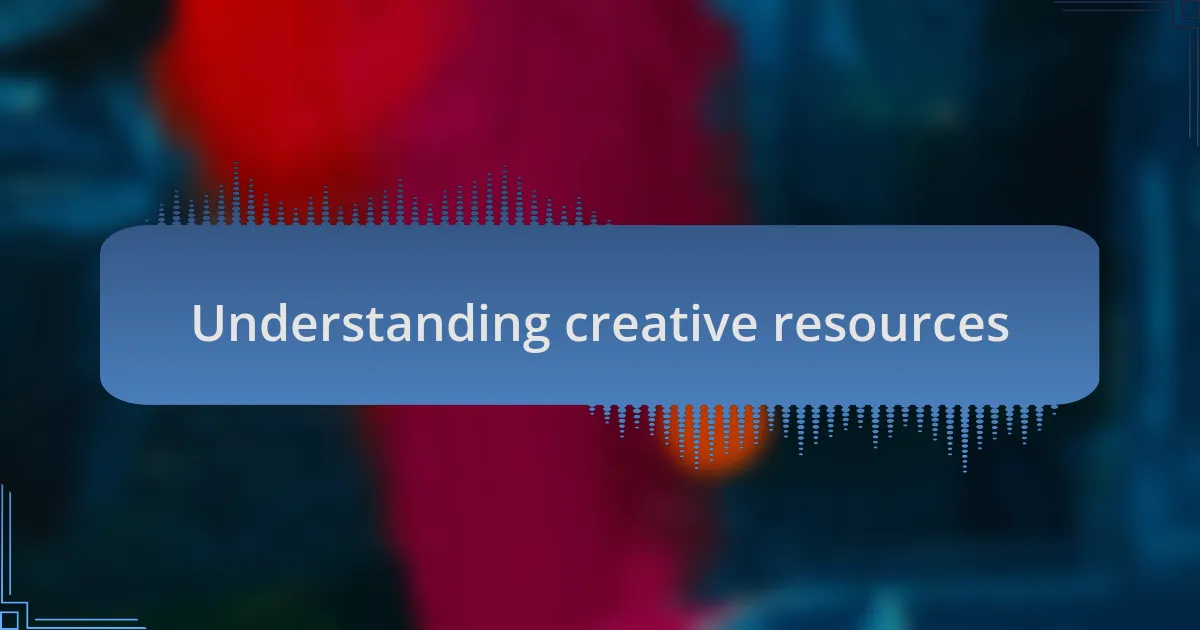
Understanding creative resources
Creative resources encompass a broad array of tools, materials, and ideas that fuel the creative process. Reflecting on my own experience, I remember how overwhelming it felt to sort through countless files, images, and notes. Have you ever lost a spark of inspiration simply because you couldn’t find the right materials? It can be frustrating, but understanding what constitutes your creative resources is the first step in taming that chaos.
In my journey, I’ve discovered that creative resources can be divided into several categories: digital assets, physical materials, and even inspiration sources. For instance, I maintain a digital library filled with articles, images, and videos that spark new ideas. How often do we think about where we draw inspiration from? Sometimes, it’s as simple as a walk in nature or browsing a favorite website.
The emotional connection we have with our resources plays a crucial role in our output. I find that certain tools or materials evoke feelings that can transform my creative process. Have you ever felt a rush of excitement when you discover a sketchbook that ignites your passion? Recognizing these emotional triggers allows us to harness our creativity more effectively and leads to more authentic work.
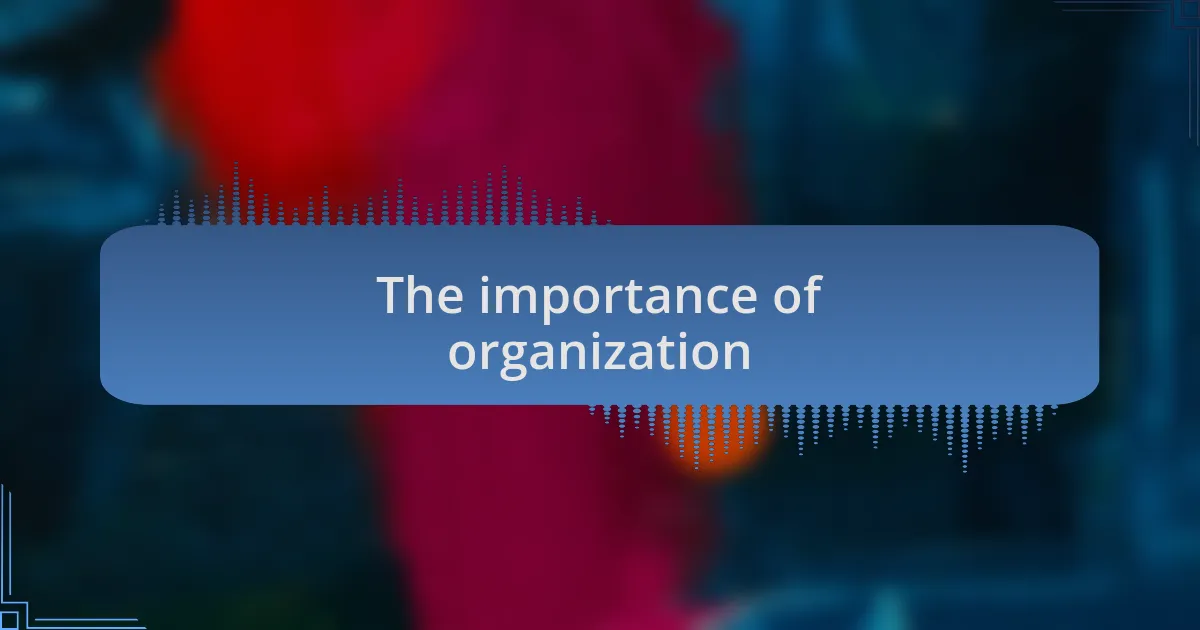
The importance of organization
Organization is the backbone of creativity. I remember a project where I scrambled to find my notes before a deadline, only to realize I’d let my materials slip into disarray. It was a stressful moment that made me appreciate how essential organization is; it allows the mind to focus on creating rather than searching.
Having a structured system for my creative resources often sparks new ideas and possibilities. I’ve noticed that when I can easily access my carefully curated files, inspiration strikes more frequently. Do you ever find that your best ideas come when you’re least stressed? An organized workspace reduces anxiety and opens the door to fresh creativity.
When I think about the impact of organization, I can’t help but recall the joy of setting up my creative space. It felt like I was crafting a sanctuary where inspiration could flourish. Does your workspace energize you, or does clutter hold you back? I genuinely believe that taking the time to organize not only fosters productivity but can also elevate the quality of our creative output.
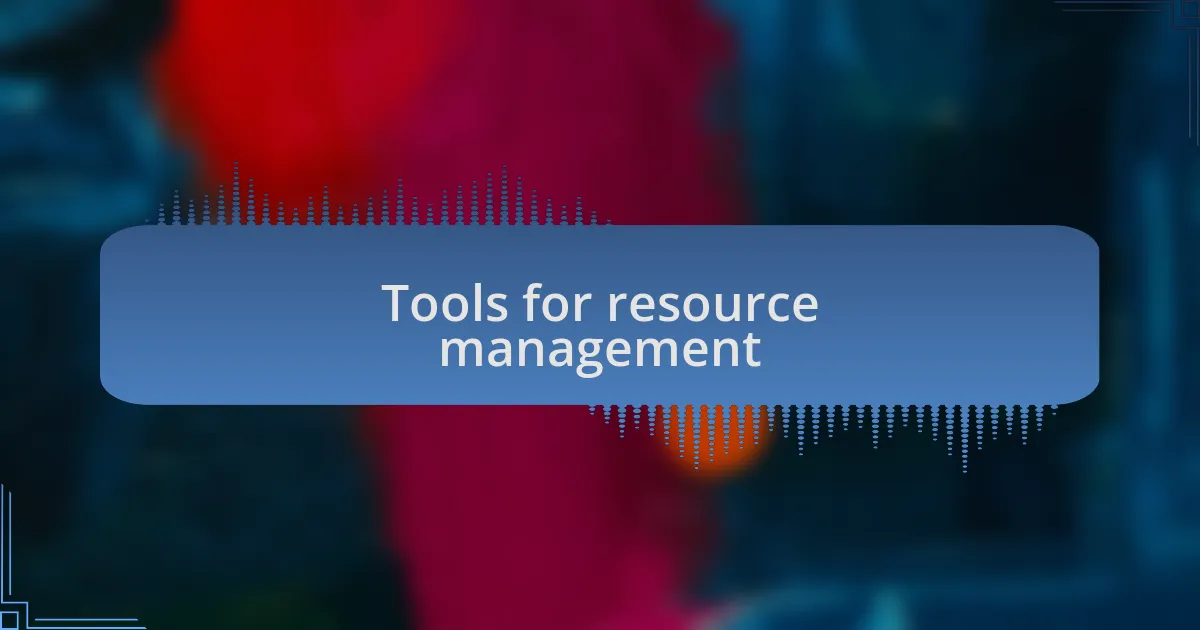
Tools for resource management
When it comes to resource management, I have discovered that utilizing digital tools can transform a chaotic environment into a streamlined haven. For instance, I use project management software like Trello to track my tasks and deadlines. It’s satisfying to see my ideas shifting from the “to do” list to the “done” column, creating a tangible sense of achievement every time I complete a task.
Another tool I find invaluable is cloud storage services like Google Drive. It allows me to store and access my creative files from anywhere, which means I can work on the go. Have you ever been struck by a burst of inspiration away from your desk? I have—countless times! Knowing that I can quickly jot down ideas and access my resources at any moment sparks a sense of freedom that fuels my creativity.
Lastly, I can’t overlook the importance of note-taking apps. For example, Evernote helps me capture random thoughts and sketches seamlessly. It’s like having a virtual brainstorming partner ready to assist me whenever creativity strikes. Don’t you love that feeling of being able to instantly organize your thoughts? By leveraging these tools, I’ve noticed a remarkable enhancement in my productivity and a deeper engagement with my creative process.

Developing a personal system
Developing a personal system has been a game changer for me. I remember the days when my creative ideas would slip away before I could even jot them down. Now, I have a dedicated notebook that stays by my side, offering me a place to capture inspiration the moment it strikes. I’m curious—do you have a go-to method to catch your thoughts before they vanish?
One key aspect of my personal system is flexibility. I’ve learned that a rigid approach can stifle creativity rather than nurture it. For instance, I often rearrange my task board as my priorities shift, allowing me to flow with my creative energy instead of forcing it into a box. How do you adapt your system when new ideas emerge? It’s this adaptability that keeps my creative engine running smoothly.
Lastly, I’m a big proponent of setting boundaries around my creative time. I’ve discovered that designating specific hours for focused work minimizes distractions and enhances my productivity. Have you found that creating a structured environment allows your creativity to flourish? Creating that balance between structure and freedom has truly empowered my artistic journey, enabling me to dive deep into my projects with confidence.
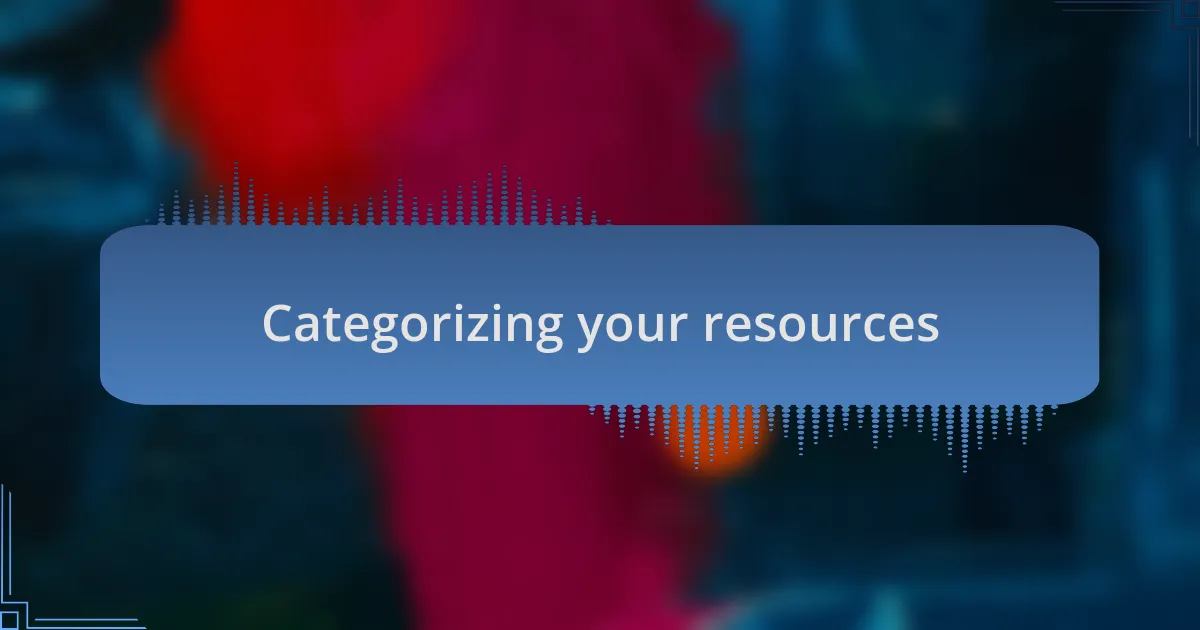
Categorizing your resources
Categorizing your resources is essential for maximizing creativity and efficiency. I often find myself grouping my materials based on projects, themes, or media types. For instance, my digital files are organized into folders labeled by project names, which makes it easy to access related inspiration or reference documents without sifting through countless files. Have you experienced the frustration of searching for that one crucial document? It’s something I’ve learned to avoid through careful categorization.
When it comes to physical resources, I like to keep a dedicated space for each category. Art supplies, for example, are arranged by color and medium on a shelf, allowing me to visually connect with what I have at hand. It’s fascinating how this simple act can spark new ideas just by seeing the materials I love. What about you? Do your physical resources inspire creativity, or is it just a cluttered mess waiting for some attention?
I also believe in regularly reviewing and refining my categorization system. Every few months, I take the time to assess what’s working and what isn’t. For example, I once discovered that I had a surplus of unused sketchbooks, and it prompted me to rethink how I allocate my creative resources. This process not only helps clear up space but also reinforces the value of what I’m truly passionate about creating. How do you keep your resources aligned with your creative journey? Being actively engaged in this review process keeps my creative energy focused and ready to tackle new challenges.
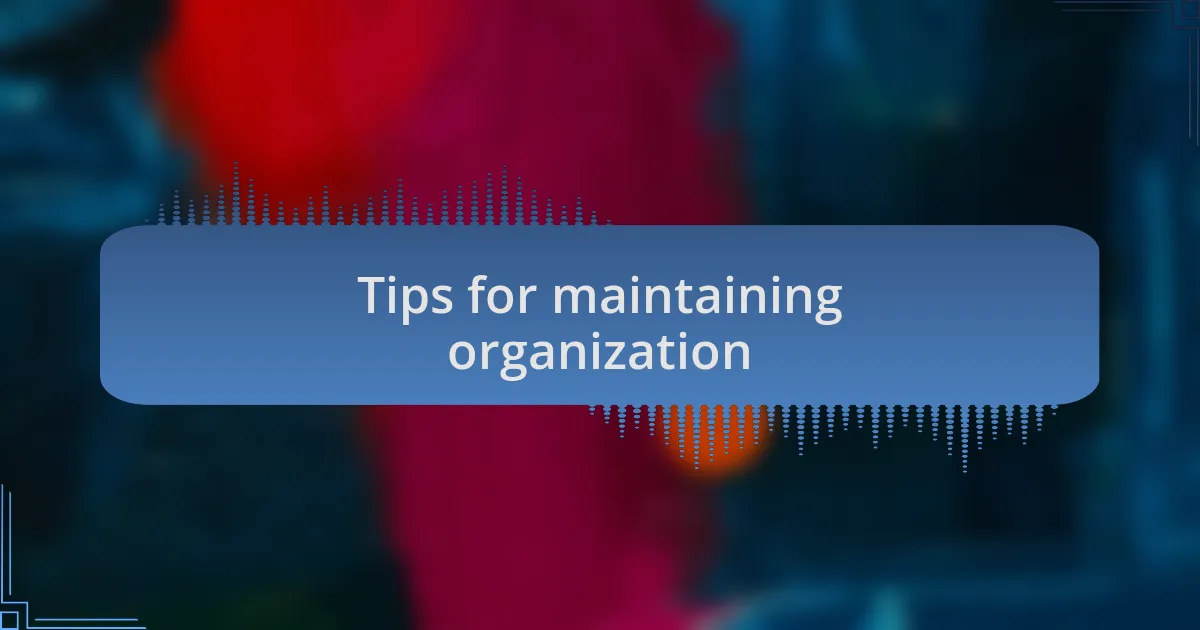
Tips for maintaining organization
Keeping my workspace clutter-free is one of the most effective tips I’ve adopted for maintaining organization. I’ve learned that a tidy environment fosters creative flow. After all, who can focus on brainstorming new ideas amidst a sea of disorganized papers and supplies? I often spend just a few minutes at the end of each day to straighten things up, and it makes such a difference. Trust me, that small effort pays off as I sit down to create the next day.
Another approach that has really helped me is setting clear goals for my creative sessions. When I sit down with a defined purpose—whether it’s drafting a new blog post or sketching an illustration—everything feels more intentional. I remember a time I wandered aimlessly, not really knowing what to tackle, and it drained my creativity. Now, I create a simple to-do list before I start, which keeps me focused and driven. Have you ever found yourself spinning your wheels without a clear direction? A little planning can turn that around!
Additionally, I find that using digital tools for organization significantly enhances my workflow. An app I love allows me to track projects and deadlines seamlessly. One day, while I was juggling multiple tasks, that app became my lifeline. It not only reminded me of impending deadlines but also helped visualize what I had left to accomplish. Have you harnessed technology to keep your creative resources in check? Embracing tools like that can simplify your life dramatically, leaving more room for innovation and creativity.
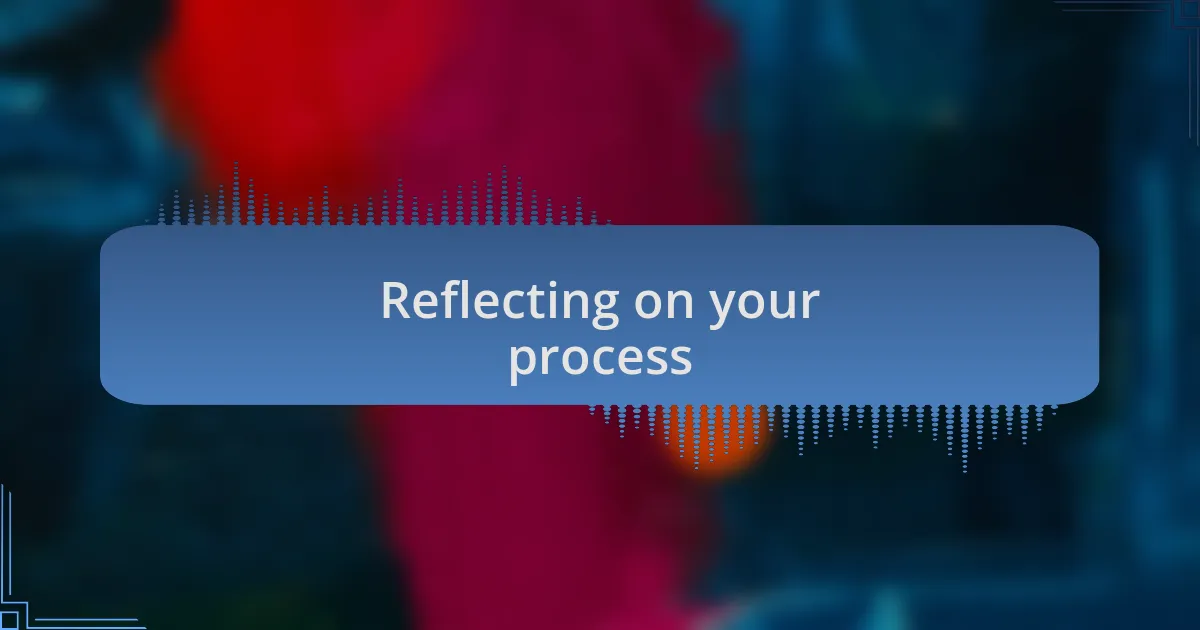
Reflecting on your process
Reflecting on my creative process has been a game changer for my productivity. I often take a moment to analyze what strategies worked well and which didn’t during my last project. This self-reflection isn’t just about finding gaps; it’s about celebrating small victories too. Have you ever thought about how much you can learn from merely looking back at your work? Revisiting my journey often sparks new ideas and fuels my motivation to push forward.
One time, I revisited a project that felt like a flop at first. As I dissected my approach, I noticed I had overlooked a crucial step in my planning phase, which led to frustration. Recognizing that missing link helped me not only adjust my current tasks but also implement stronger planning habits in future endeavors. When was the last time you revisited a past project? Taking a step back can sometimes reveal the genius in what went wrong.
I’ve also found that talking with peers about my process provides invaluable insights. Whether it’s a casual chat over coffee or a structured brainstorming session, discussing my reflections offers fresh perspectives. I remember a time when a colleague’s question made me rethink my entire concept, leading me to a breakthrough I hadn’t seen before. Have you tapped into the wisdom of your creative community? Opening up those channels of communication can truly enrich your creative practice.